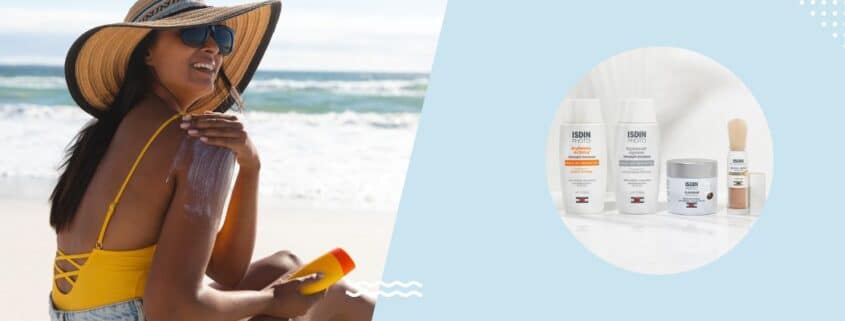How Sunscreen Protects Your Skin: Your Burning Questions Answered
If applying sunscreen isn’t already a part of your daily routine, it should be.
Unfortunately, many of us aren’t vigilant about sunscreen application. Approximately one in five Americans will experience skin cancer during their lifetimes, and nearly 10,000 people are diagnosed with a form of skin cancer in the United States every day.
Wearing sunscreen can help preserve the health and appearance of your skin regardless of age. When used appropriately, sunscreen can significantly slow external signs of aging and protect against skin cancer.
But first, what counts as sunscreen?
What’s physical sunscreen?
Physical sunscreen, or sunblock, is a form of sun protection that acts as a barrier between the skin and ultraviolet (UV) radiation. UV radiation is a form of invisible, short-wavelength energy from the sun and certain types of artificial light sources (tanning beds). As ionizing radiation, UV energy can remove electrons from molecular and atomic structures, which affects the DNA in living tissues, potentially leading to cancer.
UV radiation is divided into three categories:
- Ultraviolet A (UVA): UVA radiation is most commonly associated with photoaging (wrinkles) and certain skin cancers.
- Ultraviolet B (UVB): UVB radiation has a slightly longer wavelength than UVA. UVB rays are associated with sunburn and especially dangerous forms of skin cancer, notably malignant melanoma.
- Ultraviolet C (UVC): UVC radiation has the shortest wavelength of the three types of UV energy, but UVC radiation is only produced artificially; the ozone layer filters out almost all UVC rays from the sun. UVC radiation is used to disinfect surfaces. It can cause significant damage to the skin and eyes.
Physical sunscreens contain minerals that reflect UV rays away from the skin, preventing absorption and UV damage. The Food and Drug Administration (FDA) approved minerals are titanium dioxide and zinc oxide.
Clothing can also act as physical sunscreen if made of materials that effectively block UV radiation. It is the most effective form of body sunscreen because it provides a continual barrier that does not have to be reapplied (unlike liquid sunscreens). Sun-protective clothing is made from fabrics with a UPF (ultraviolet protection factor). However, it’s important to learn the manufacturer’s maintenance instructions; a garment’s UPF can degrade over time.
What’s chemical sunscreen?
Chemical sunscreens provide sun protection by disrupting UV radiation and dissipating it after it has been absorbed into the skin. The active ingredients in chemical sunscreens in the United States are avobenzone, homosalate, octinoxate, octisalate, octocrylene, and oxybenzone.
Chemical sunscreens are easily absorbed into the skin and do not leave visible residue (some physical sunscreens can leave a white cast on the skin). However, some people experience inflammation, redness, and other reactions to certain ingredients in chemical sunscreens.
While both physical and chemical sunscreens offer numerous sun-protecting benefits, most products contain a combination of mineral and chemical active ingredients, effectively providing double-duty sun protection.
What is SPF?
SPF is an initialism for Sun Protection Factor. SPF measures the amount of protection a sunscreen provides against UV radiation.
The SPF of a product is determined by the amount of time it takes for sunburn to occur when a person is wearing sunscreen compared to the amount of time it takes for sunburn to occur without sunscreen. The higher the SPF, the more protection a sunscreen provides.
The CDC recommends using a sunscreen with at least SPF 15, which will block 93 percent of UVB rays.
What are broad-spectrum sunscreens?
It is important to use sunscreen that offers broad-spectrum protection, which protects against UVA and UVB rays. While a sunscreen’s SPF is important, the product’s ability to protect against both types of radiation is crucial in preventing sun damage.
How much sunscreen should I apply?
Most people do not use enough sunscreen to be effective. The recommended amount of sunscreen for the face, ears, and neck is approximately one teaspoon. If you aren’t wearing sun-protective clothing, you should apply sunscreen to the body, too. Approximately two tablespoons should provide sufficient coverage, depending on body size and the amount of exposed skin.
If you plan to spend several hours in direct sunlight, reapply your sunscreen every two hours for maximum protection. If you anticipate swimming or sweating heavily, a water-resistant sunscreen is essential.
Do I need to apply sunscreen when I’m not spending time outdoors?
Yes! It’s best to wear sunscreen at all times, if only to protect against accidental sun exposure. If you spend a great deal of time near a window (and you aren’t sure if the windows have UV filters) or have long commutes, sunscreen can protect you.
Consult a dermatologist to learn which type of sunscreen is best for your skin.



